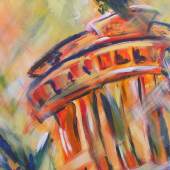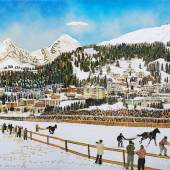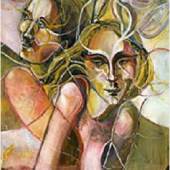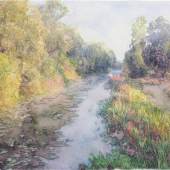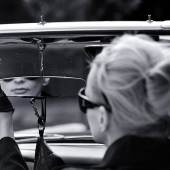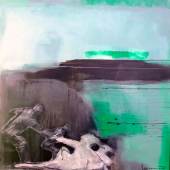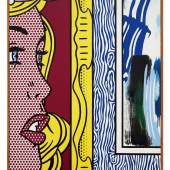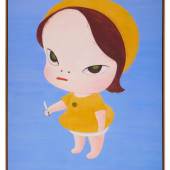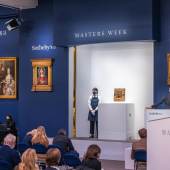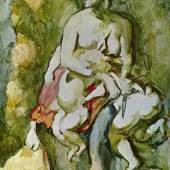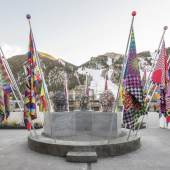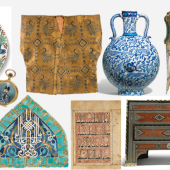Arts of the Islamic World 25 April 2018, Sotheby’s London
-
Ausstellung25.04.2018
Ottoman society was fairly permissive in the sixteenth century, more conservative in the seventeenth and quite liberal in the eighteenth – and so manuscripts produced in this last period show vibrant and explicit scenes. Indeed, it was a rather common genre in the
literature of the time. This text is a curated compendium of several manuals using incredibly expensive materials and a number of artists from different ateliers. It is also important to note that gender was not considered a dichotomy in Ottoman Turkey, and there a multiple examples of the heterosexual and homosexual (more extensive cataloguing available on request).
A unique blue and white pilgrim flask with animals, Turkey, circa 1545-55 (est. 60,000-80,000)

Bearing testimony to the breadth of experimentation of Iznik potters, this unique blue and white flask is the only known example of this distinctive shape. The elegance of the contours and playfulness of the design hail from varying traditions that have evolved and come together in this ground-breaking piece. Decorated in the early blue and turquoise of the mid-sixteenth century and adorned with a fantastical mix of animals, it is one of the earliest instances in which this popular design first appeared. The origin of this form can be traced back to pilgrimages in pre-Islamic times, associated with Middle Bronze age pottery vessels and the use of natural materials such as animal-skin gourdes. This example portrays the unmistakeable desire of the potter to create an organic form matching the leather prototypes – a difficult feat that is achieved in the accentuated curvature of the body. Iznik wares are best-known for their creative floral designs, blending the Ottomans’ most loved flowers, yet animals were also favoured as a decorative motif. Although these painterly forms recall the ‘animal chase’ tradition seen on Persian metalwork, alluding to the courtly pastime of the hunt, this style is likely to have been derived from the Balkans. Balkan silverwork was popular during the reigns of Ahmed I, Osman II and Murad IV.
The closest comparisons to this Iznik flask are also the only known examples of their kind – a glass pilgrim bottle from the Mamluk era held in the British Museum and a metalwork silver-inlaid canteen attributed to mid-thirteenth century Syria, in the Smithsonian Institute.
An illuminated Hilye, signed by Mahmud Celaleddin (d.1829), Turkey, Ottoman, dated 1202 AH/1787-88 AD (est. £10,000- 15,000) A perfect example of the specific genre of Ottoman Turkish literature that denoted a physicial description of the Prophet based on hadith accounts, this Hilye is signed by the eminent Ottoman calligrapher Mahmud Celaleddin. Althought thought to be self- taught, he devloped a distinctive style that was much admired by Sultan Abdülmecid (r.1839-61) and used for the inscriptsion inside the foundation of the revered Eyüp Sultan Mosque in Istanbul.
CELEBRATING MEDIEVAL MATHEMATICS, ASTRONOMY & SCIENCE
The auction offers three highly important medieval manuscripts on astronomy, maths and medicine of the utmost rarity, giving an insight into the scientific advances developed and practised during the Islamic Golden Age. Owing to the medieval Arabic scientific tradition, many Greek texts have been preserved and transmitted to future generations through the centuries. These three early works were copied in the twelfth and thirteenth  centuries in North Africa and Persia, and bear witness to this important phase of conveying Classical knowledge.
Kamal al-Din al-Hasan ibn 'Ali ibn al-Hasan al-Farisi, 'The Book of Correction of Optics for those who have Sight and Mind', autograph copy, Persia, probably Tabriz, dated 708 AH/1309 AD. (est. £250,000-350,000) This early autograph copy of Al-Farisi's landmark work is of exceptional historical importance, drawing on the work Greek scholars Euclid, Ptolemy, Aristotle and Galen, and covers various elements of optics, the physics of the eye, as well as light, vision, reflection, refraction. A remarkable cross-sectional diagram may be the earliest
known illustration of the human eye.
An important Arabic translation of Euclid's elements, probably Egypt, 13th century (est. £200,000-300,000) The ‘Elements’ by Euclid is considered one of the pillars of mathematics. This finely written copy is densely illustrated with finely-executed diagrams and marginal notes, combining elegant naskh for the main text and thuluth for the titles. Majisti batlamiyus al-taʿalimi fi l-taʿalim, an early abridgement of Ptolemy's Almagest, Persia, dated 671 AH/1272 AD (est. £200,000-300,000) Ptolemy’s Almagest was the most influential text on astronomy for 1,500 years until Copernicus’ tome, and this unique manuscript contains the only known copy of an abridgement from Thabit b. Qurra’s seemingly lost translation. The Greek original was first translated into Arabic, by the order of the Caliph al-Ma'mun during the first half of the ninth century, before it was then translated into Latin.
-
15.11.2021 - 19.11.2021Sotheby’s Lifts the Curtain onOne of the Most Important Sales Series Ever Staged $1 BILLION...
-
18.11.2021Sotheby’s To Announce Live Bidding Increments in Ether (ETH) Cryptocurrency For Banksy...
-
28.01.2022Sotheby’s New York Master Paintings and Sculpture Part ITotals $91 MillionSecond Highest...
-
Wo Sie die Werke Cézannes besichtigen können: Kunsthaus, Zürich „Das...
-
20.04.2024 - 24.11.2024Jeffrey Gibson on Representing the United States and Himself By Melissa Smith | Feb 16, 2024 From...
-
11.12.2024Iconic Heuer Monaco Worn by Steve McQueen in LeMansRaces to Auction at Sotheby’s New York...
-
25.04.2018
.
